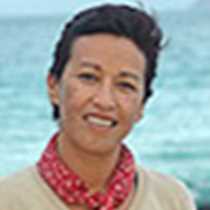Punta Vicente Roca on Isabela Island and Punta Espinosa on Fernandina Island
The sun rose above Wolf Volcano on the Northern extreme of Isabela Island, the largest island of the Galápagos. The fresh breeze and the quietness of the sea invited us to relax and enjoy the navigation. At about 8:30am Lucho, the Expedition Leader, called us to the bridge where the Captain showed us in the GPS screens. They showed that we were about to cross the Equator, jumping from the Northern to the Southern Hemisphere. We certainly did not feel any bump, as some of the guests might have expected, but the Equatorial line was there, I can assure you that!
Once at Punta Vicente Roca the Zodiacs were launched and the ride started; the kayakers instead went off to explore the shear-cut cliffs formed by volcanic rocks; the ledges of the cliffs were teaming with life: sea lions, blue-footed boobies, flightless cormorants, enormous marine iguanas and the third smallest penguin of the world, the Galápagos penguin!
This small penguin species arrived many years ago to the islands, perhaps pushed by the strong, cold and nutrient-rich Humboldt Current which bathes the islands from June thru December. Due to the varied environment and to the low food supply during the rest of the year, they modified their body sizes thus turning into the third smallest of all penguins. During the “El Niño year” of 1982-83, the population drastically dropped from its original number of three thousand individuals to only ten percent of it; the populations are doing a good comeback and from time to time we are delighted to see a big number of them either swimming and fishing in front of snorkelers or sunbathing in front of their nesting sites.
For the afternoon the Islander sailed off southwestwards to reach the westernmost and most pristine Island perhaps in the whole world, Fernandina. With very fresh lava flows, hundreds of iguanas lay flat on them, sharing this pre-historic looking environment with sea lions, flightless cormorants, American Oystercatchers and orange-redish colored sally light foot crabs. As you set foot on the island one can understand with no doubt why this is the most favorite island for the naturalists.
At the end of the day as the sun was disappearing on the horizon, we came back on board feeling that we have renewed our spirits on the last lost paradise of the world.
The sun rose above Wolf Volcano on the Northern extreme of Isabela Island, the largest island of the Galápagos. The fresh breeze and the quietness of the sea invited us to relax and enjoy the navigation. At about 8:30am Lucho, the Expedition Leader, called us to the bridge where the Captain showed us in the GPS screens. They showed that we were about to cross the Equator, jumping from the Northern to the Southern Hemisphere. We certainly did not feel any bump, as some of the guests might have expected, but the Equatorial line was there, I can assure you that!
Once at Punta Vicente Roca the Zodiacs were launched and the ride started; the kayakers instead went off to explore the shear-cut cliffs formed by volcanic rocks; the ledges of the cliffs were teaming with life: sea lions, blue-footed boobies, flightless cormorants, enormous marine iguanas and the third smallest penguin of the world, the Galápagos penguin!
This small penguin species arrived many years ago to the islands, perhaps pushed by the strong, cold and nutrient-rich Humboldt Current which bathes the islands from June thru December. Due to the varied environment and to the low food supply during the rest of the year, they modified their body sizes thus turning into the third smallest of all penguins. During the “El Niño year” of 1982-83, the population drastically dropped from its original number of three thousand individuals to only ten percent of it; the populations are doing a good comeback and from time to time we are delighted to see a big number of them either swimming and fishing in front of snorkelers or sunbathing in front of their nesting sites.
For the afternoon the Islander sailed off southwestwards to reach the westernmost and most pristine Island perhaps in the whole world, Fernandina. With very fresh lava flows, hundreds of iguanas lay flat on them, sharing this pre-historic looking environment with sea lions, flightless cormorants, American Oystercatchers and orange-redish colored sally light foot crabs. As you set foot on the island one can understand with no doubt why this is the most favorite island for the naturalists.
At the end of the day as the sun was disappearing on the horizon, we came back on board feeling that we have renewed our spirits on the last lost paradise of the world.




